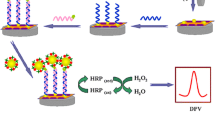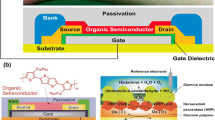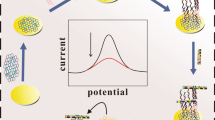Abstract
A significant challenge for high throughput nucleic acid analysis and sequencing is to increase both throughput and sensitivity. Electrical detection methods are advantageous since they can be easily scaled to high density arrays, are highly sensitive, and do not require bulky optical equipment for readout. A focus of most nucleic acid based sensors is the detection of sequence-specific hybridization events between complementary strands of DNA or RNA. These hybridization events can be detected electrically, due to the intrinsic negative charge associated with the phosphate-rich nucleic acid backbone. Field effect transistors (FETs) and high electron mobility transistors (HEMTs) are ideal devices for detecting such hybridization events, due to their high sensitivity to changes in electrical field strength. A key concern for the construction of DNA-based FET and HEMT biosensors is the immobilization of probe oligonucleotides on the active region of the sensor. In previous work, our group has shown that single stranded DNA can be directly immobilized onto semiconductor materials without the need for complex surface chemistry or crosslinking strategies. In the present work, we have shown that the immobilization of single stranded DNA onto these materials is influenced by the terminal phosphate group of the DNA molecule, independent of backbone phosphates. This agrees with previous studies in which phosphates and phosphonates exhibited strong attachment to a variety of metal oxides. We have also shown that surface-immobilized DNA is available for hybridization and that hybridization is sequence specific. Phosphate-dependent immobilization was demonstrated for HfO2, AlGaN, and ZrO2 surfaces using optical detection of DNA-DNA hybridization, as well as x-ray photoelectron spectroscopy (XPS) analysis of DNA-modified surfaces.
Similar content being viewed by others
References
A. Sassolas, B. D. Leca-Bouvier, and L. J. Blum, “DNA Biosensors and Microarrays,” Chem. Rev., vol. 108, p. 31, 2008.
F. R. R. Teles and L. P. Fonseca, “Trends in DNA Biosensors,” Talanta, vol. 77, p. 18, 2008.
H. Im, X. Huang, B. Gu, and Y. Choi, “A dielectric-modulated field-effect transistor for biosensing,” Nature Nanotechnology, vol. 2, pp. 430–434, 2007.
B. S. Kang, Pearton, S.J., Chen, J.J., Ren, F., Johnson, J.W., Therrien, R.J., Rajagopal, P., Roberts, J.C., Piner, E.L., Linthicum, K.J., “Electrical detection of deoxyribonucleic acid hybridization with AlGaN/GaN high electron mobility transistors,” in Materials Research Society Symposium, 2007.
N. M. Fahrenkopf, S. Oktyabrsky, E. Eisenbraun, M. Bergkvist, H. Shi, and N. C. Cady, “Phosphate Dependent DNA Immobilization on Hafnium Oxide for Bio-sensing Applications,” Proceedings of the Materials Research Society, 2009.
H. Byrd, J. K. Pike, and D. R. Talham, “Inorganic Monolayers Formed at an Organic Template: A Langmuir-Blodgett Route to Monolayer and Multilayer Films of ZIrconium Octadecylphosphonate,” Chem. Mater., vol. 5, p. 7, 1993.
W. Gao, L. Dickinson, C. Grozinger, F. G. Morin, and L. Reven, “Self-Assembled Monolayers of Alkylphosphonic Acids on Metal Oxides,” Langmuir, vol. 12, p. 7, 1996.
E. L. Hanson, J. Schwartz, B. Nickel, N. Koch, and M. F. Danisman, “Bonding Self-Assembled, Compact Organophosphonate Monolayers to the Native OXide Surface of Silicon,” J. AM. CHEM. SOC., vol. 125, p. 7, 2003.
M. L. Jespersen, C. E. Inman, G. J. Kearns, E. W. Foster, and J. E. Hutchison, “Alkanephosphonates on Hafnium-Modified Gold: A New Class of Self-Assembled Organic Monolayers,” J. AM. CHEM. SOC., vol. 129, p. 5, 2007.
X. Xu, V. Jindal, F. Shahedipour-Sandvik, M. Bergkvist, and N. C. Cady, “Direct immobilization and hybridization of DNA on group III nitride semiconductors “ Applied Surface Science, vol. 255, pp. 5905–5909, 2009.
R. D. Clark, S. Consiglio, C. S. Wajda, G. J. Leusink, T. Sugawara, H. Nakabayashi, H. Jagannathan, L. F. Edge, P. Jamison, V. K. Paruchuri, R. Iijima, M. Takayanagi, B. P. Linder, J. Bruley, M. Copel, and V. Narayanan, “High-K Gate Dielectric Structures by Atomic Layer Deposition for the 32nm and Beyond Nodes,” ECS Transactions, vol. 16, p. 14, 2008.
R. D. Clark, C. S. Wajda, G. J. Leusink, L. F. Edge, J. Faltermeier, P. Jamison, B. P. Linder, M. Copel, V. Narayanan, M. Gribelyuk, R. Loesing, and R. Murphy, “Process and Electrical Characteristics of MO-ALD HfO2 Films for High-K Gate Applications Grown in a Production-Worthy 300 mm Deposition System,” ECS Transactions, vol. 11, p. 15, 2007.
W. S. Rashband, “ImageJ,” Bethesda, MD: US National Institutes of Health, 1997–2008.
Z.-C. Liu, X. Zhang, N.-Y. He, Z.-H. Lu, and Z.-C. Chen, “Probing DNA hybridization efficiency and single base mismatch by X-ray photoelectron spectroscopy,” Colloids and Surfaces B: Biointerfaces, vol. 71, p. 5, 2009.
Author information
Authors and Affiliations
Rights and permissions
About this article
Cite this article
Fahrenkopf, N.M., Jindal, V., Tripathi, N. et al. Exploiting Phosphate Dependent DNA Immobilization on HfO2, ZrO2 and AlGaN for Integrated Biosensors. MRS Online Proceedings Library 1236, 516 (2009). https://doi.org/10.1557/PROC-1236-SS05-16
Received:
Accepted:
Published:
DOI: https://doi.org/10.1557/PROC-1236-SS05-16




